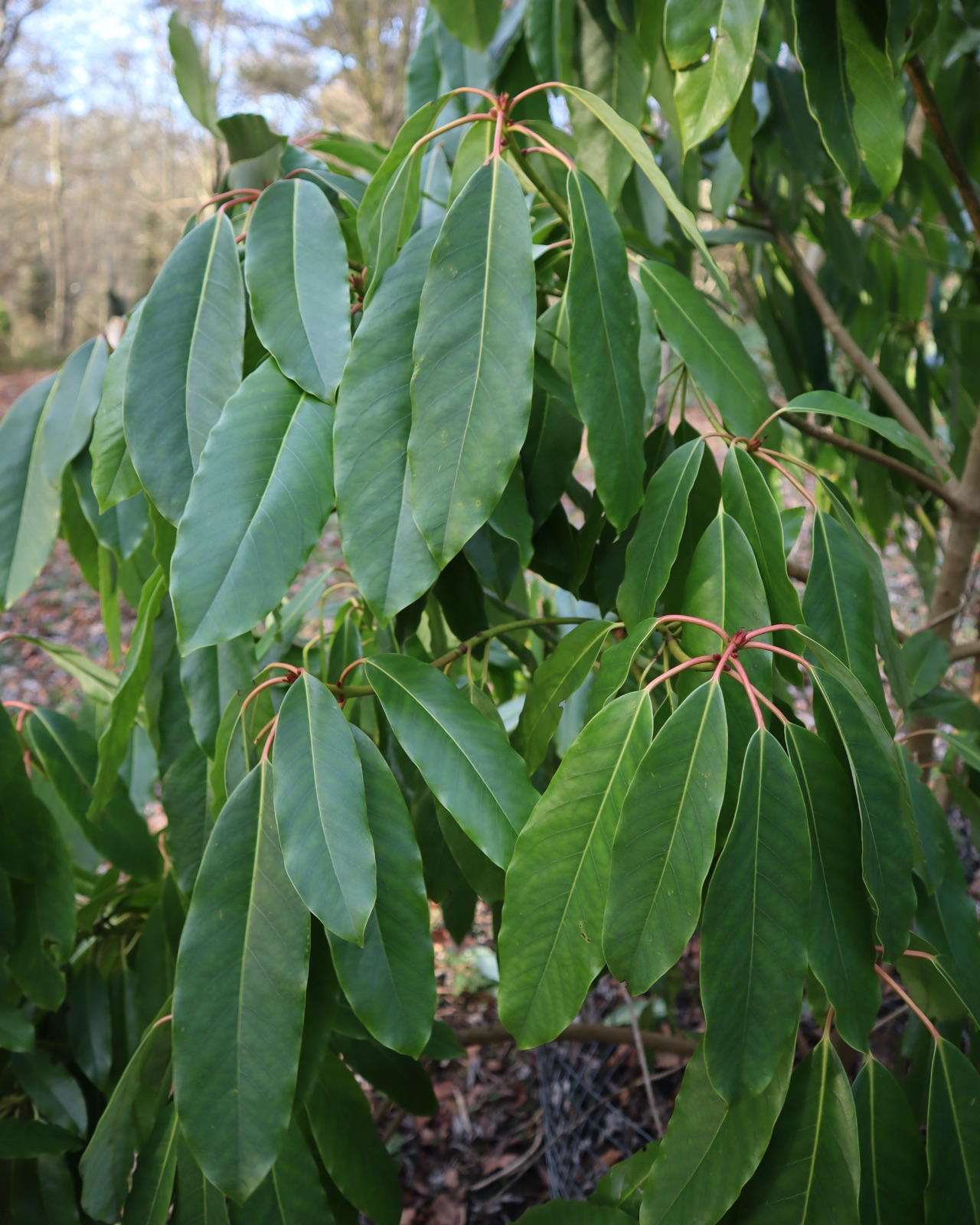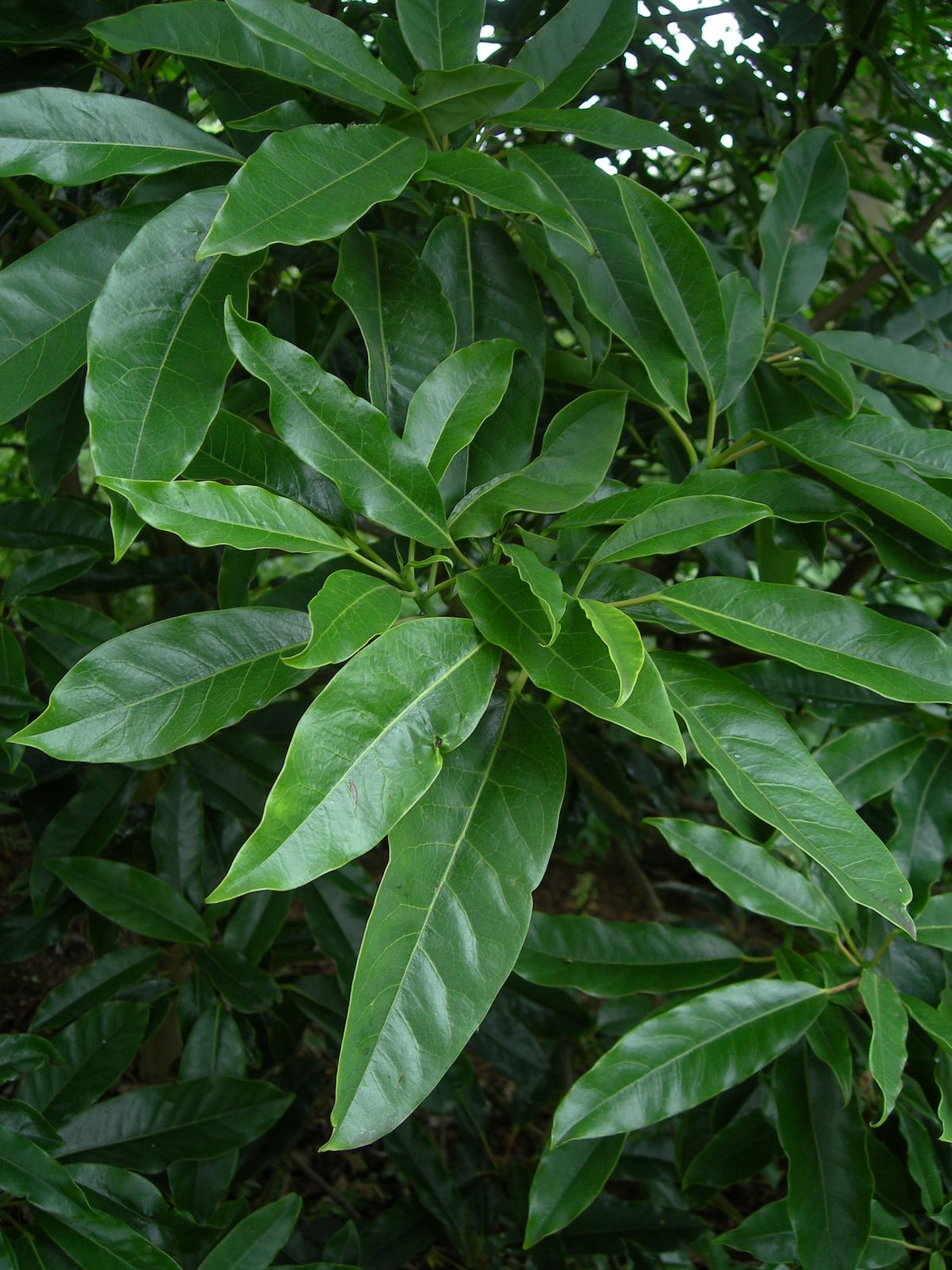Daphniphyllum pentandrum
Credits
Article from New Trees by John Grimshaw & Ross Bayton
Recommended citation
'Daphniphyllum pentandrum' from the website Trees and Shrubs Online (treesandshrubsonline.
Genus
Synonyms
- D. oldhamii (Hemsl.) K. Rosenthal
- D. glaucescens Blume var. oldhamii Hemsl.
- D. glaucescens auct. non Blume
- D. kengii Hurus. (and others not used in horticulture)
Shrub or tree 4–10 m. Branchlets slender, brown. Leaves fasciculate, 9–14 × 2.5–4 cm, lanceolate, oblong-or obovate-lanceolate to oblong, firmly papery, upper surface glossy green, lower surface glaucous and minutely papillose, lateral veins 8–15 pairs, slender, prominent on both surfaces, reticulate veins prominent above, margins revolute, apex acute to acuminate or shortly caudate, base cuneate or obtuse; petiole green or reddish, 2–3.5 cm long, slender. Female inflorescence 4–6 cm long, male inflorescence 2–4 cm, both with slender pedicels bearing minuscule flowers. Drupes dark brown with abundant glaucous wax, ellipsoid to obovate-globose, 0.8 × 0.6 cm, skin slightly tuberculate. Flowering March to May, fruiting August to November (China). Min & Kubitzki 2008. Distribution CHINA: Fujian, Guangdong, Hubei, Hunan, Jiangxi, Taiwan, Zhejiang; KOREA; JAPAN. Habitat Forests, between 100 and 1400 m asl. USDA Hardiness Zone (7b–)8. Conservation status Not evaluated. Taxonomic note Authorities differ about the name of this plant. The Kew Checklist uses D. pentandrum Hayata (1911) as the oldest specific name, but Flora of China uses D. oldhamii (not applied at specific level until 1919). As it is clear that both authorities refer to the same taxon, the prior name must be applied. The name D. glaucescens Blume should be restricted to a species found in Malaysia and Indonesia.
The wide range of this species is reflected in the variation seen in both the wild populations and cultivated specimens. In particular there is considerable variation in glaucescence. In the best forms the lower leaf surfaces are brightly white, while the new shoots flush a rich coppery red, making a very striking effect as the old and new leaves are seen together. The fruits are also very glaucous and can be freely produced, forming an important part of the display. The plants will vary somewhat in habit, but generally make a broad, somewhat shrubby tree, often as wide as it is tall. There are several very good specimens in the David C. Lam Asian Garden in Vancouver, the oldest dating to 1980. When seen in 2004 this was about 7 m tall, forming a bushy, rounded tree with two principal stems, although where branches sag to the ground they send up further vertical shoots. In dense forest it could clearly be drawn up into a single-stemmed tall tree, potentially becoming an emergent over 30 m tall (Wharton et al. 2005), but in more open situations the shrubby habit may predominate. The Vancouver specimen is not particularly glaucous, but its leaves, carried on pinkish red petioles, are bold and handsome. Also growing well at Vancouver are specimens from ETOT 0134 (Flanagan & Kirkham 2005), ‘making huge shrubs trying to be trees 5–6 m high, with highly variable new growth color from bronze-red, mahogany-red to reddish orange, all with a varnish sheen’ (P. Wharton, pers. comm. 2007). All happily survived the –9 ºC and heavy wet snow experienced in early November 2006. How hardy material from different provenances will be remains to be tested in a range of conditions.
Material is also available in commerce under the name D. kengii (for example, BSWJ 6872, BSWJ 7119), collected at lower altitudes in northern Taiwan from plants with a dwarfer, shrubbier habit than D. pentandrum, achieving only 2 m in height (Crûg Farm Plants 2007–2008). This has a rather different appearance, but may fit here as a local variant. It is also rather more tender, only just surviving –11ºC at Crûg Farm (B. Wynn-Jones, pers. comm. 2007).


